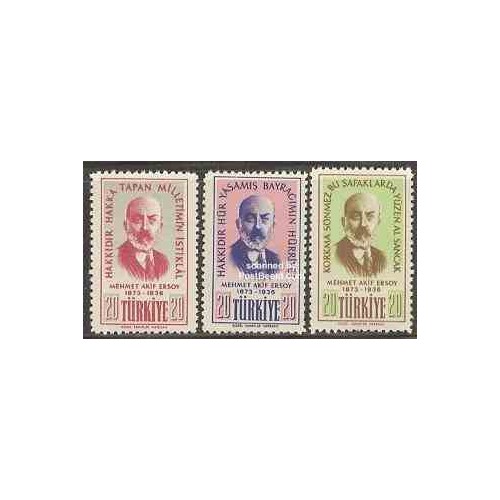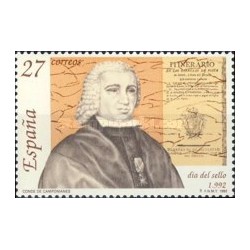- جدید
- ناموجود



توجه : درج کد پستی و شماره تلفن همراه و ثابت جهت ارسال مرسوله الزامیست .
توجه:حداقل ارزش بسته سفارش شده بدون هزینه پستی می بایست 100000 ریال باشد .
در صورت نیاز به راهنمائی لطفا با شماره 09381506644 تماس بگیرید.
Mehmet Âkif Ersoy (20 December 1873 – 27 December 1936) was a Turkish poet, writer, academic, member of parliament, and the author of the Turkish National Anthem. Widely regarded as one of the premiere literary minds of his time, Ersoy is noted for his command of the Turkish language, as well as his patriotism and role in the Turkish War of Independence.
A framed version of the national anthem by Ersoy typically occupies the wall above the blackboard in the classrooms of every public as well as most private schools around Turkey, along with a Turkish flag, a photograph of the country's founding father Atatürk, and a copy of Atatürk's famous inspirational speech to the nation's youth.
He currently has a university in his name in Burdur. Ersoy's portrait was depicted on the reverse of the Turkish 100 lira banknotes of 1983–1989.[2]
| Mehmet Akif Ersoy | |
|---|---|
 |
|
| Born | 20 December 1873 |
| Died | 27 December 1936 (aged 63) |
| Occupation | Poet, author, politician |
| Nationality | Turkish |
| Literary movement | The Republican Era |
| Notable works | Safahat |
| Website | |
| www |
|
Ersoy was born as Mehmet Akif in İstanbul, Ottoman Empire in 1873 to İpekli Tahir Efendi (1826-1888), an Albanian from İpek district born in the village Shushica of Istok, modern day Peja in Kosovo and tutor at the Fatih Madrasah,[3] at a time when all institutions of the state were in terminal decline, and major crises and regime changes were underway. His mother, Emine Şerife Hanım, was of mixed Uzbek and Turkish descent.[4] As he was about to complete his education at the Fatih Merkez Rüştiyesi, his father's death and a fire that destroyed his home, forced Ersoy to interrupt his education and to start working to support his family. He wanted to start a professional career as soon as possible, and he entered the Mülkiye Baytar Mektebi (Veterinary School), and graduated with honors in 1893.
In the same year, Mehmet Akif Ersoy joined the civil service and conducted research on contagious diseases in various locations in Anatolia. During these assignments, in line with his religious inclination, he gave sermons in mosques, and tried to educate the people and to raise their awareness. Along with fellow men-of-letters Recaizade Mahmut Ekrem, Abdülhak Hamit Tarhan and Cenap Şahabettin, which he had met in 1913, he worked for the publication branch of the Müdafaa-i Milliye Heyeti. He soon resigned from his government position and other occupations, and wrote poems and articles for the publication Sırat-ı Müstakim.
During the collapse of the Ottoman Empire, Mehmet Akif Ersoy was a fervent patriot. He made important contributions to the struggle for the declaration of the Turkish Republic, and advocated patriotism through speeches that he delivered in many mosques in Anatolia. On 19 November 1920, during a famous speech he gave in Kastamonu's Nasrullah Mosque, he condemned the Treaty of Sèvres, and invited the people to use their faith and guns to fight against Western colonialists. When the publication Sebilürreşat, which was then operating out of Ankara, published this speech, it spread all over the country and was even made into a pamphlet distributed to Turkish soldiers.
However, Mehmet Akif Ersoy earned himself his significant place in the history of the Republic of Turkey as the composer of the lyrics of the Turkish National Anthem. During the session of 12 March 1921, the Turkish Grand National Assembly officially designated his ten-quatrain poem as the lyrics of the national anthem.
Mehmet Akif Ersoy is an important national figure in the history of modern Turkey and has left an immortal trace in its history. During the republican period, Mehmet Akif Ersoy taught history and literature at various universities.
Ersoy moved to Cairo in 1925 and taught the Turkish language at a university there during his 11-year stay. He caught malaria during a visit to Lebanon and returned to Turkey shortly before his death in 1936.
He was interred in the Edirnekapı Martyr's Cemetery in Istanbul and was the first person in the history of the Republic of Turkey to have the national anthem performed at his funeral ceremony.
Mehmet Akif Ersoy had abundant knowledge concerning traditional eastern literature. In addition, during the years he was studying at Veterinary school, he enjoyed reading the works of authors such as Victor Hugo, Alphonse de Lamartine, Émile Zola, and Jean-Jacques Rousseau.
He is best known for his 1911 work entitled Safahat. This volume is a collection of 44 poems of various lengths by Mehmet Akif Ersoy. The earliest work that appears in this book is dated 1904, but this is unattested, and it is highly likely that the poet, who was 32 on that particular date, composed poems prior to that date.
He is further noted for writing the lyrics of Turkish National Anthem, İstiklâl Marşı (The March of Independence in English) – which was adopted in 1921, and is accepted by many Turks as their "National Poet". The lyrics were originally written as a poem in a collection of his writings. Paradoxically, one of his most famous works, a book called Safahat, was not widely read or published until recently. He studied veterinary science at the university.
تشکر نظر شما نمی تواند ارسال شود
گزارش کردن نظر
گزارش ارسال شد
گزارش شما نمی تواند ارسال شود
بررسی خود را بنویسید
نظر ارسال شد
نظر شما نمی تواند ارسال شود

check_circle
check_circle


















